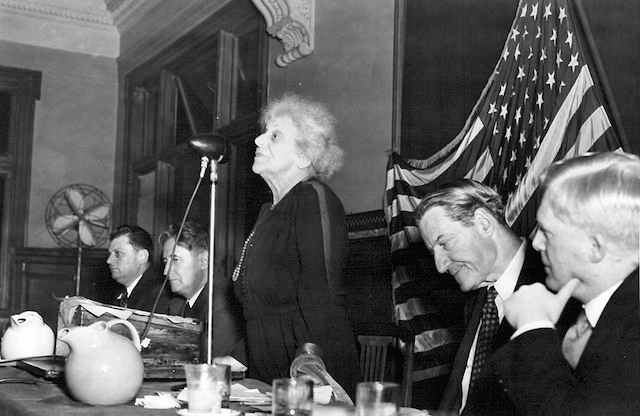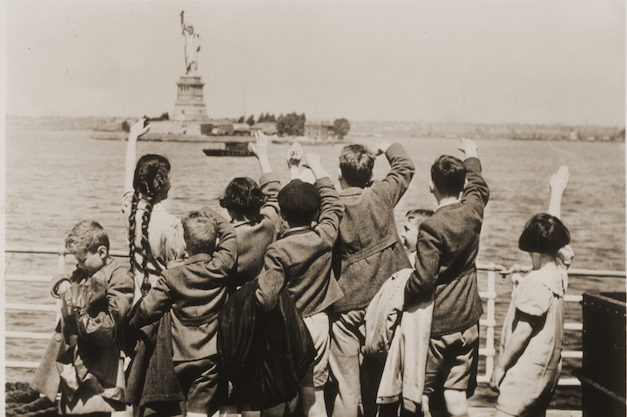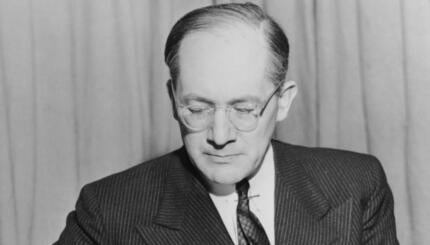During World War II, rescue of Jews and other victim groups persecuted by Nazi Germany was not a priority for the United States government.
Immigration in the 1930s and 1940s
The U.S. Congress passed new, restrictive quota laws in 1924 that limited the number of immigrants who could enter the U.S. from Europe each year. During the Nazi period, these quotas often were not filled, even though thousands of Jewish refugees sought admittance to the U.S. from Nazi Germany and Nazi-occupied territories.
Once the Great Depression began in 1929, President Herbert Hoover instructed the State Department to enforce the quota laws very strictly, which made it very difficult for refugees in the 1930s to obtain immigrant visas. Immigrants needed to prove they were not “likely to become a public charge” and had the financial resources to support themselves indefinitely in the United States. Despite the ongoing persecution of Jews in Germany, public and government attitudes related to immigration were influenced by the economic hardships of the Great Depression, which intensified anti-Semitism, isolationism, and xenophobia. After World War II began in 1939, American consuls abroad also screened refugees on national security grounds, making an already difficult immigration process even harder.
With your help, My Jewish Learning can provide endless opportunities for learning, connection and discovery.
READ: What Americans Had to Say About Jewish War Refugees
Nevertheless, in 1939 and 1940 more than half of all immigrants to the United States were Jewish, most of them refugees from Europe. During those same years, a majority of all immigration to the United States came from Nazi-occupied or collaborationist countries. In 1940, for instance, 82 percent of immigrants to America came from these countries, most of them refugees seeking asylum. But by the time the United States entered the war in December 1941, American consulates had already closed in most of Europe and it became nearly impossible for refugees to escape the continent. Despite many obstacles, however, more than 200,000 Jews found refuge in the United States from 1933 to 1945, most of them arriving before the end of 1941.
U.S. State Department and the “Final Solution”
In August 1942, the State Department received a report sent by Gerhart Riegner, the Geneva-based representative of the World Jewish Congress (WJC). The report revealed that the Germans were planning to physically annihilate the Jews of Europe. Believing the news to be a rumor — and feeling that any rescue action was impossible even if the report was true — State Department officials did not forward the report to its intended recipient, Rabbi Stephen Wise, who was president of the World Jewish Congress.
Despite the State Department’s obstruction, Wise soon received the report via British channels, and asked the State Department to investigate the information. Three months later, Undersecretary of State Sumner Welles confirmed Riegner’s information for Rabbi Wise. On Nov. 24, 1942, Wise held a press conference to announce that Nazi Germany was implementing a policy to annihilate the European Jews. A few weeks later, on Dec. 17, the United States, Great Britain, and 10 other Allied governments issued a declaration denouncing Nazi Germany’s atrocities and warning that perpetrators of such crimes would be held responsible for their actions.

U.S. Press Coverage of the “Final Solution”
During World War II, the American press did not always publicize reports of Nazi atrocities in full or give them prominent placement in the papers. Newspapers had reported on Nazi violence against Jews in Germany as early as 1933, as well as the Nuremberg Laws of 1935 and the expanded German anti-Semitic legislation in 1938 and 1939. The nationwide state-sponsored terror against Jews of Nov. 9-10, 1938 — known as Kristallnacht (Night of Broken Glass) — made front-page news across the U.S. as did Hitler’s infamous prediction, expressed to the Reichstag (German parliament) on Jan. 30, 1939, that a new world war would mean the extermination of the Jewish “race.”
As the magnitude of anti-Jewish violence increased in 1939-1941, many American newspapers ran descriptions of German shooting operations by the Einsatzgruppen, first in Poland and later after the invasion of the Soviet Union. The ethnic identity of the victims was not always made clear to American readers. Some reports described German mass murder operations with the word “extermination.” As early as July 2, 1942, the New York Times reported on the operations of killing center in Chelmno based on sources from the Polish underground. In part because of the inability to verify the information, the first article, on Chelmno, appeared on page six of the newspaper. Newspapers’ coverage of the December 1942 Allied statement condemning the mass murder of European Jews generally did appear on the front page.
Very few reports of what we now understand as the Holocaust included photographs. Visual evidence of Nazi atrocities became more common in American newspapers and magazines after May 1945, in the final days of the war and the immediate aftermath of Allied victory.
Reprinted with permission from the United States Holocaust Memorial Museum‘s Holocaust Encyclopedia.



